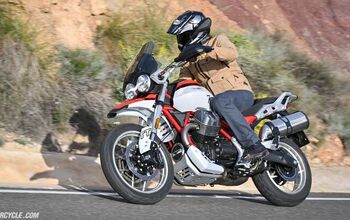2001 Suzuki RM125 - Motorcycle.com
Torrance, California, October 02, 2000 -- Ever notice how difficult it is to witness certain events and not be affected by them?
For instance, how many among us can say we watched a certain Arnold Schwarzeneggar movie and for the next week avoided warning others "I'll be back" in our best Austrian accent?
Darn few, I'd wager.
Imagine, then, if you'd witnessed Travis Pastrana's latest competitive exploit - winning the X Games for the second year in a row, followed by winning both motos of the 125 cc National in Millville, Minnesota. Wouldn't you be interested in trying to do all your own meager talents permitted in trying to emulate him? Of course you would.
So, I showed up at 7:30 the next morning to find Suzuki box vans, tents and personnel already bustling in a corner of Southern California's Lake Elsinore motocross complex. More importantly, I found a 2001 RM125 with the "Reserved-for-Motorcycle Online" tag on it.
The '01 RM125 has a number of changes from the millenium edition. As with the new RM250, Suzuki wanted to make the 125 lighter yet stronger and more aggressive. Many of the chassis changes on the '01 RM250 also found their way to the little brother, resulting in a new RM125 that weighs a claimed 198 pounds dry. Yes, that's four pounds heavier than the 2000 but, as we pointed out in the RM250 story, Suzuki concentrated on where the weight went so that - despite the added weight - the bike feels lighter.
In addition to centralizing mass better than before, Suzuki tucked the steering head in from 27.8 to 26.5 degrees and chopped trail from 114mm (4.5 inches) to 104mm (4.1 inches), both of which should yield quicker steering. In addition, 5mm (less than a quarter-inch) has come off the wheelbase which now measures 57.1 inches.
The new RM125 retains its Showa suspension, but it's been revised considerably. To reduce weight and work in tandem with the more rigid frame, the inner fork tubes are 47mm, instead of 49. Internally, the fork springs sit in the bottom of the tubes, submerged in the fork oil. Suzuki claims this helps change the air pressure and improve the air/spring load effect as the twin chamber fork compresses.
The shock body is still 50 mm in diameter but, like the 250's shock, it rides in a needle bearing on its top mount. The piggyback-style reservoir features both high- and low-speed compression damping adjusters. At 12.6 inches, claimed wheel travel is the same as the 2000's.
While the new RM125's engine doesn't boast as many changes as found in the '01 RM250's, there are a number of significant updates.
Discerning eyes will notice that the cylinder sits more vertically now and Suzuki's press notes confirm this: Instead of 20-degrees, the cylinder is inclined only 17-degrees. Suzuki says this straightens the intake tract enough in the case reed motor to increase charging efficiency and realize greater power from midrange up. The engineers also played with the exhaust port to bump up output in that part of the powerband.
Like the 250, the 125 power plant is also shorter from front to back, due in part to relocating the water pump from inside the crankcase to its new position on the outside and just in front of the clutch cover. And like the 250, the 125 utilizes a smaller-diameter ignition rotor, compensating for the reduced flywheel effect by bumping up crankshaft inertia via slightly heavier crank halves.
Replacing the 2000's 38mm Keihin PWK Power Jet carb with a 38mm Mikuni TMX ends up shedding 104 grams or about 3.7 ounces. Part of that weight loss is due to the fact that the Mikuni is 16mm (0.6 inches) shorter from front to back of the carb bore for better throttle response. The Mikuni flows as much as the Keihin. Suzuki, therefore, deemed the old Power Jet system unnecessary, thus saving a few more grams while not losing any power in the process.
There's a new exhaust with lighter-gauge steel plus an aluminum mount, saving more than 290 grams (10 ounces) of weight. In addition, the aluminum silencer also is lighter by 30 grams (a little more than an ounce).
The new engine output also suggested revised gear ratios in the six-speed transmission. Suzuki responded with a slightly taller first and slightly lower second, aiming for more holeshots on those oh-so-critical starts. The 125 gets its link-type shifting to a gear-type as in the 250 for better shift feeling. Numerous other changes reduce gearbox weight slightly.
Suzuki's "Tool Time" Tim set the sag at 98mm before my first ride; 100mm is the usual setting, but since the bike was new, he felt 98 would take me through the day better. It was initially checking in at only 80 mm before he adjusted it, which tells us that the RM comes with a shock spring that should easily handle fast leapers since I'm only of "decent" pace, weighing in at 165 pounds.
Gradually, I got the hang of the various twists and turns on the track laid out on what used to be the bottom edge of Lake Elsinore and introduced a little speed in carefully measured amounts. The RM responded wonderfully as I got up to speed, getting onto the main jet down the straights and out of some corners.
After a couple sessions, I was getting comfortable enough with the track to clear the huge table-tops, though Pastrana need not worry about me taking his job anytime soon. One thing that we learned at the RM250 intro last month was that the RM125 seat is taller and provides a flatter platform. Riding the 125, the top of the seat did indeed prove to be flat enough to permit you to slide unimpeded almost up to the gas cap. No bodywork caught on boots or knee braces either, making weight shifts and clambering around the bike easy.
Curiously, the RM125 didn't feel quite as willing to hit the inside of a corner at Elsinore as I remembered the RM250 doing at Beaumont. Whether due to Elsinore's dirt, my biorhythms or whatever, the RM125 felt more comfortable keeping it pinned in a faster outside line or taking advantage of a rut berm down lower than if forced to hang to the flat, featureless inside. For now, chalk it up to the nut on top of the bike.
Armed with more speed meant hitting jumps a bit more seriously and - Lord, almighty! - I actually cleared one, then another and another!
Coming up a bit short on others didn't exact a painful toll or any metal-to-metal bottoming. The rear end soaked up bit hits superbly, whether off jumps or in whoops. The front felt just a bit more harsh at the bottom of the stroke, but raising the oil level a few millimeters or otherwise taking some time to dial it in solved that.
It's hard to compare different bikes simply by memory, especially on different days and tracks, but the '01 RM125 felt as if it pulled a little better off the bottom and into the midrange than the '01 KTM 125 SX we tried a couple weeks ago, though the SX may have an edge on top power. However, the Suzuki seemed easier to ride, overall.
And that indicates to me that the '01 RM125 will be an excellent machine, one with enough flexibility to tolerate a turtle's pace as well as Pastrana's. Though I harbor no illusions of comparing to his talents, that doesn't mean I can't have fun as well, and I ended up having lots of it on Suzuki's latest RM125.
More by Mark Kariya
































Comments
Join the conversation